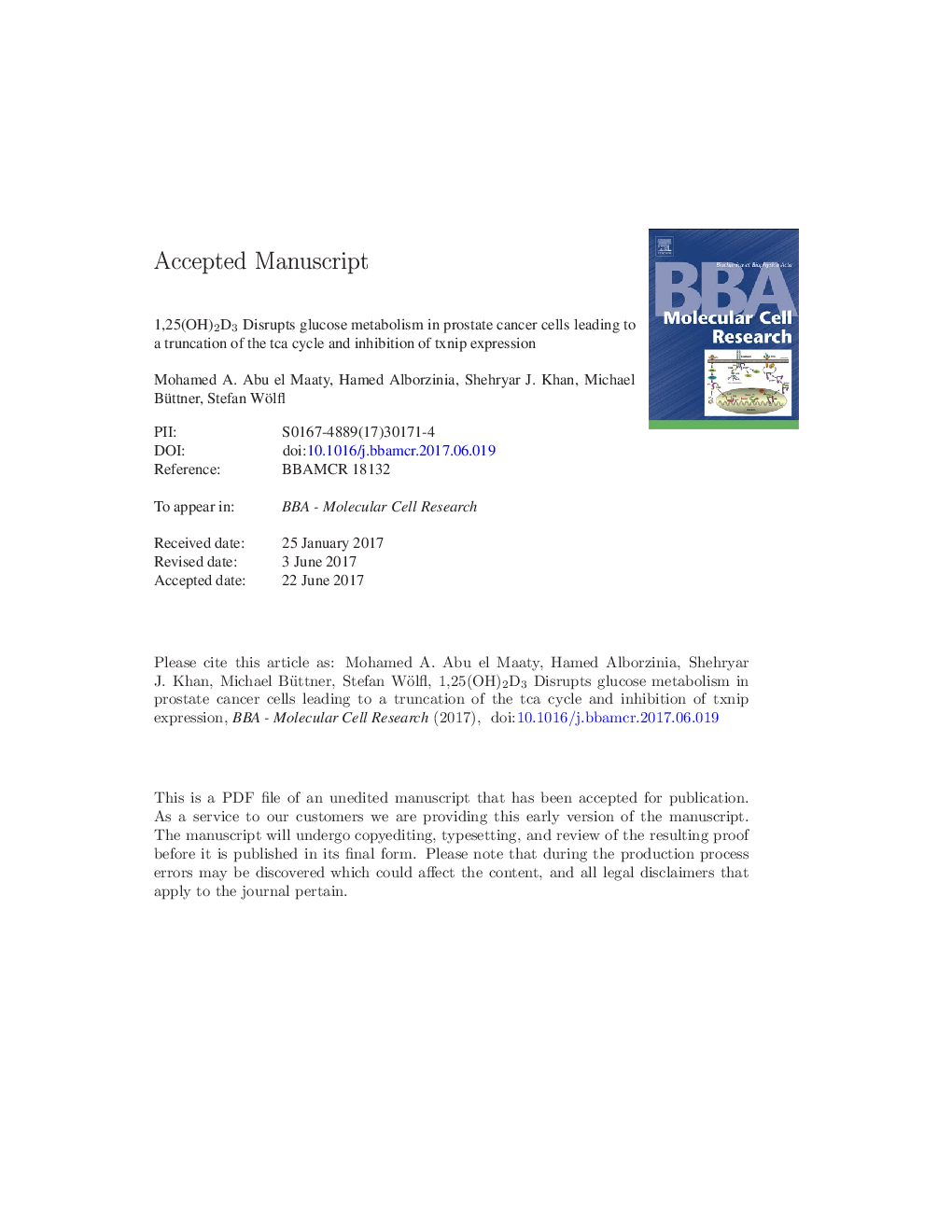| کد مقاله | کد نشریه | سال انتشار | مقاله انگلیسی | نسخه تمام متن |
|---|---|---|---|---|
| 5508823 | 1400401 | 2017 | 48 صفحه PDF | دانلود رایگان |
عنوان انگلیسی مقاله ISI
1,25(OH)2D3 disrupts glucose metabolism in prostate cancer cells leading to a truncation of the TCA cycle and inhibition of TXNIP expression
دانلود مقاله + سفارش ترجمه
دانلود مقاله ISI انگلیسی
رایگان برای ایرانیان
کلمات کلیدی
CaMKK2DGHIF12-DeoxyglucoseVDRVDUP1ACLYATP citrate lyaseG6PGLUT1TXNIPACACASDHCLDHAMLXIPLMlxPDHK1AMPKOGDHLKB1FDG-PETACCPSA1,25(OH)2D3 - 1،25 (OH) 2D31,25-dihydroxyvitamin D3 - 1،25-دی هیدروکسوییتامین D3AMP-activated protein kinase - AMP-پروتئین کیناز فعال شده استPCA - PCAProstate specific antigen - آنتی ژن اختصاصی پروستاتacetyl coA carboxylase - استیل کولا کربوکسیلازfatty acid synthase - اسید چرب سنتازfluorodeoxyglucose-positron emission tomography - توموگرافی منتشر شده توسط فلوئوریدوکسلوژن-پوزیترونProstate cancer - سرطان پروستاتhypoxia-inducible factor 1 - عامل القایی هیپوکسی 1Fasn - فسادLactate dehydrogenase A - لاکتات دهیدروژناز AMetabolism - متابولیسم thioredoxin-interacting protein - پروتئین تعامل کننده تیورودکسینPyruvate dehydrogenase kinase 1 - پیرووات دهیدروژناز کیناز 1TCA cycle - چرخه TCAtricarboxylic acid cycle - چرخه اسید تریکاربوکیلیکglucose transporter 1 - گلوکز 1glucose-6-phosphate - گلوکز 6-فسفاتAndrogen Receptor - گیرنده آندروژنیVitamin D receptor - گیرنده ویتامین D
موضوعات مرتبط
علوم زیستی و بیوفناوری
بیوشیمی، ژنتیک و زیست شناسی مولکولی
زیست شیمی
پیش نمایش صفحه اول مقاله

چکیده انگلیسی
Prostate cell metabolism exhibits distinct profiles pre- and post-malignancy. The malignant metabolic shift converts prostate cells from “citrate-producing” to “citrate-oxidizing” cells, thereby enhancing glucose metabolism, a phenotype that contrasts classical tumoral Warburg metabolism. An on-line biosensor chip system (BIONAS 2500) was used to monitor metabolic changes (glycolysis and respiration) in response to the putative anti-cancer nutraceutical 1,25-dihydroxyvitamin D3 [1,25(OH)2D3], in different prostate cancer (PCa) cell lines (LNCaP, VCaP, DU145 and PC3). LNCaP cells exhibited profound metabolic responsiveness to the treatment and thus extensive analysis of metabolism-modulating effects of 1,25(OH)2D3 were performed, including mRNA expression analysis of key metabolic genes (e.g. GLUT1 and PDHK1), analysis of TCA cycle metabolites, glucose uptake/consumption measurements, ATP production, and mitochondrial biogenesis/activity. Altogether, data demonstrate a vivid disruption of glucose metabolism by 1,25(OH)2D3, illustrated by a decreased glucose uptake and an accumulation of citrate/isocitrate due to TCA cycle truncation. Depletion of glycolytic intermediates led to a consistent decrease in TXNIP expression in response to 1,25(OH)2D3, an effect that coincided with the activation of AMPK signaling and a reduction in c-MYC expression. Reduction in TXNIP levels in response to 1,25(OH)2D3 was rescued by an AMPK signaling inhibitor and mimicked by a MYC inhibitor highlighting the possible involvement of both pathways in mediating 1,25(OH)2D3's metabolic effects in PCa cells. Furthermore, pharmacological and genetic modulation of the androgen receptor showed similar and disparate effects on metabolic parameters compared to 1,25(OH)2D3 treatment, highlighting the AR-independent nature of 1,25(OH)2D3's metabolism-modulating effects.
ناشر
Database: Elsevier - ScienceDirect (ساینس دایرکت)
Journal: Biochimica et Biophysica Acta (BBA) - Molecular Cell Research - Volume 1864, Issue 10, October 2017, Pages 1618-1630
Journal: Biochimica et Biophysica Acta (BBA) - Molecular Cell Research - Volume 1864, Issue 10, October 2017, Pages 1618-1630
نویسندگان
Mohamed A. Abu el Maaty, Hamed Alborzinia, Shehryar J. Khan, Michael Büttner, Stefan Wölfl,